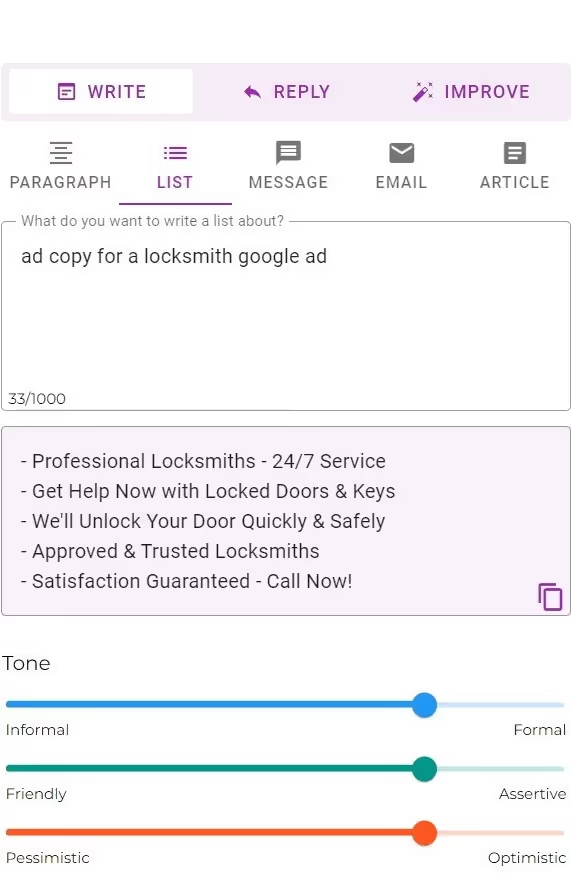Join us for an exciting upcoming webinar, "AI for Business Leaders," designed specifically for business owners and professionals to gain valuable insights and practical knowledge applying AI to industry specific use cases! This free workshop will showcase how professionals at leading organizations, including NASA and The Home Depot, are leveraging AI to enhance productivity and drive success. Create a free account and request an invitation by emailing events@paragraphai.com today!

Creating successful ad copy can be a challenge, especially if you are new to the process. With a few tips and tricks, you can master the art of writing effective ad copy. This will help you capture the attention of your target audience and persuade them to take action. This blog post covers basics of how to write ad copy and provides helpful advice to get your copy noticed and increase conversions.
Ad copy is a form of persuasive writing used to promote a product, service, or brand. It is typically used in various forms of advertising such as print, social media, television ads, and on websites.
Ad copy is designed to attract attention, create interest, and persuade potential customers to take action. Though the length of the copy may vary, it is important that is concise and to the point.
Ad copy should be crafted with the intent of convincing potential customers to make a purchase. In a clear and concise manner, it should communicate the product's features and benefits, explain why the product is unique and better than the competition, and provide a sense of urgency by using emotional language.
Additionally, you should write ad copy with the target audience in mind, using empathy and phrasing that resonates with them. Finally, ad copy should include a call-to-action like a discount code. This encourages readers to take the next step and make a purchase or sign up for a subscription.
When learning how to write ad copy, you should initially consider the space that your ad will use. Is it going to occupy an entire social media post or a small Google result? Your ad structure will determine the amount of creative resources you will need for effective ad copy.

(Source: Alex Cattoni)
Headlines need to be placed at the bottom of the post when writing ads for social media, such as Facebook or Instagram. This means that the most eye-catching part of your copy should be in the description, as that is what viewers will see first while scrolling through their feed.
A first impression is key here, as whether or not someone will pay your ad any conscious attention entirely depends on it. For your advertising to be successful, you will need a hook to draw in your audience.
Using language that generates curiosity and instills urgency, such as limited time offers, is an effective means of catching people's attention. However, Facebook only provides 125 characters, limiting the delivery of eye-catching statements before it gets cut off. You'll need to make them count!
For your headline, you'll want it to clearly state what your offer is. Do not assume that your audience has read the post. Underneath you can put a brief description, which can provide other information about the offer or present a catchy phrase. Most importantly, it should not simply state redundant information.

(Source: Kinsta)
Google ads have a simpler ad copy structure in that they are only made up of three components: the headline text, display URL, and description text. Since headlines typically run around 30 characters, and the description texts at about 90 characters, you'll need to deliver a succinct and to the point explanation of your service in order to get the most out of what little space you have.
Your primary goals are highlighting what makes you unique, including important keywords, and providing calls to action to empower the viewer get started. The best way to accomplish this is by using short and simple phrases that answer the potential consumer's needs.
Trying to come up with ad copy that sends the right message? ParagraphAI, a free AI writing tool, can help you make the process easier. Depending on what kind of copy you're planning to create, there's a tool that's just right for it!
For short and to-the-point ads suitable for social media, you can make use of the Message feature. This feature is designed to create customized concise statements.

With these results, you have a good starting point for your copy to help give you inspiration for the eye-catching description you'll need to attract your audience. Just make sure that your final copy doesn't exceed the site's character limit.
Using ParagraphAI's List feature, you can prompt this free AI writing tool to create ad copy suitable for Google ads. It will generate clear, concise phrases that you can use for your ad.

For the best results, try adjusting the sliders at the bottom to match the tone you are going for. For instance, an assertive tone is usually most effective at creating convincing statements for your description. Most importantly though, you can run it as many times as you need for different results, helping you brainstorm even more ideas.
Creating effective, convincing ad copy for businesses or organizations can be a daunting task for anyone new to advertising. However, learning how to write ad copy is much simpler today with the amount of resources at your disposal.
With ParagraphAI, use your copywriting knowledge and a little inspiration to make your ad copy stand out among the competition.